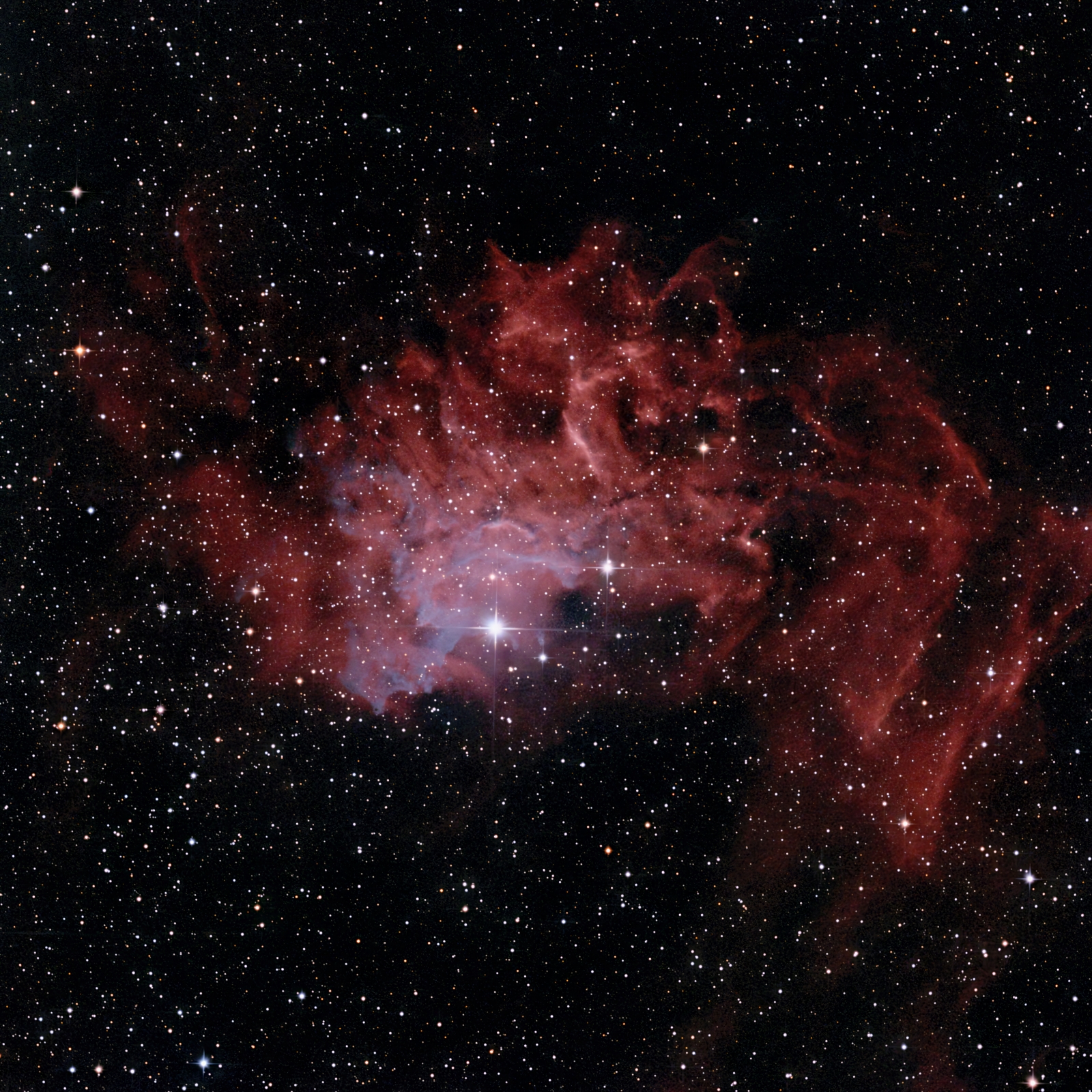

IC 405, THE FLAMING STAR, on 2023-12-12
The Flaming Star Nebula (IC 405) is an emission and reflection nebula located approximately 1,500 light-years away in the northern constellation Auriga. The nebula surrounds the hot blue variable star AE Aurigae. With an apparent magnitude of 6.0 and an apparent size of 37 by 10 arcminutes. IC 405 is illuminated by the young O-type main sequence dwarf AE Aurigae. It was named the Flaming Star Nebula because it contains extensive smoke-like filaments that make AE Aurigae look like it is on fire in long-exposure photographs. The nebular material that looks like smoke is mostly composed of hydrogen, but the dark filaments are made up of carbon-rich dust. The Flaming Star Nebula is about five light-years across. It is composed of different regions that glow in red, purple, and blue tones in images. The hot blue star AE Aurigae emits so much light that it knocks away electrons from the gas that surrounds it, ionizing the nebula. When a high-energy proton emitted from the hot star recaptures an electron, red light is often emitted and the nebula glows red. The red regions comprise the emission nebula. Other parts of the nebula glow in bluish tones because the blue light of the hot star is reflected by the surrounding dust. The blue parts make up the reflection nebula. The purple parts of the nebula are a mix of emission and reflection regions. The nebula is catalogued as Caldwell 31 in the Caldwell catalogue of deep sky objects visible in amateur telescopes. It has the designation Sharpless 229 (Sh2-229) in the Sharpless catalogue of H II regions. AE Aurigae is a young main sequence star of the spectral type O9.5V. It is an exceptionally hot, massive, and luminous star. It has a mass 23 times that of the Sun and a radius 7.47 times the Sun. With an effective temperature of 33,000 K, it is 59,000 times more luminous than the Sun. Even though it is only a few million years old, AE Aurigae will not live very long. O-type stars burn through their supply of hydrogen fuel fast due to their high mass and go out as supernovae in less than 10 million years. AE Aurigae is classified as an Orion variable star. It exhibits irregular variations in luminosity and its brightness varies from magnitude 5.78 to 6.08. The star lights up the Flaming Star Nebula, but the nebula is not its birthplace. The two have different radial velocities. AE Aurigae is a runaway star believed to have originated in the Trapezium Cluster in the Orion Nebula (Messier 42). Runaway stars pass through the interstellar medium at supersonic velocities. Based on measurements of the radial velocity and proper motion of AE Aurigae, astronomers believe that the star’s point of origin intersects with the multiple-star system Iota Orionis. AE Aurigae may have been expelled during a collision of two massive binary systems about 2-3 million years ago. Iota Orionis in Orion’s Sword may have taken part in the collision. The hot blue stars Mu Columbae and 53 Arietis might have also been ejected in the same collision. AE Aurigae has only recently run into IC 405 and is now interacting with the dense molecular nebula. Once it leaves the nebula, IC 405 will fade. As the star passes through IC 405 at high speed, it creates a powerful bow shock, producing a large number of high-energy protons that can be detected in X-rays. In 2012, a team of astronomers detected X-ray emissions from the bow shock. This was the first instance of the detection of X-ray emission from a bow shock created by a runaway star.
This This photo was taken in Kyle, Texas, through a 6-inch
f/4 Telescope, on a Sky-Watcher EQ6-R mount, with a ZWO ASI533MC PRO color
camera, plus an Optolong L Pro Light Polution Filter. The total image
acquisition time is: 07 hrs 04 min 00 sec.
Full Size View Full size files are very large and can take a minute to download. After downloading the full-size picture to zoom in or out on a computer hold down the Ctrl key and use the scroll mouse button, or you can press the + or - key.